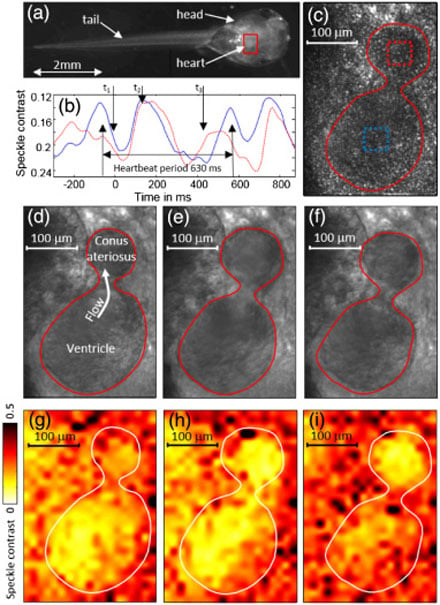A solid-state degenerate laser system that can provide efficient methods of coherence switching has demonstrated the ability to provide both speckled and speckle–free images. The technology enables multimodality imaging from a single laser, where low spatial coherence illumination can be used for traditional high-speed videomicroscopy and high spatial coherence illumination for extracting dynamic information of flow processes. Although multimodality imaging has been achieved previously using different light sources, it has been challenging to maintain optical alignment during switching and adjust for mismatches in illumination intensity.
Researchers from Yale University developed a simple design that features only five optical elements plus a vertical external-cavity surface-emitting laser (VECSEL). The VESCEL is used to allow two types of microscopy images to be acquired with a single light source. The system is designed to switch back and forth between different operating modes using essentially the same beam. Since the direction and optical powers of the operating modes are similar, system alignment is maintained.
The VECSEL emits light from multiple sites, with the light from each site slightly out of step with all the others. All 1,000 independent modes of light coming from the VECSEL were used to generate low-coherence light. By adding a pinhole to the laser cavity, the researchers were able to concentrate all the laser power into just a couple of modes to create high-coherence light for laser speckle contrast imaging.
The discovery grew out of the researchers’ work to develop a laser that could eliminate the speckle pattern that obscures images acquired using laser light. The single-source laser system can create light with low spatial coherence for speckle-free structural images or be quickly switched to high spatial coherence for speckle contrast imaging of the same tissue.
Illuminating a sample with a non-coherent light, such as that from LEDs or a white lamp, eliminates speckle. However these light sources aren’t bright enough for the fast imaging speeds, and thus short exposure times, required to follow dynamic biomedical processes such as a beating heart.
In developing the single-source laser, the researchers took advantage of the fact that the particular pattern of speckle created by a sample can provide information about the dynamics of the cells scattering the light. Since the 1990s, a method called laser speckle contrast imaging has used the temporal change of speckle to provide information about blood flow.
 The researchers conducted an initial demonstration of their light source by imaging a beating heart from a Xenopus tadpole. They first acquired low-coherence images to show the heart’s structure and how it changes during a heartbeat. They then switched to high coherence to measure the flow of blood through the heart using laser speckle contrast imaging.
The researchers conducted an initial demonstration of their light source by imaging a beating heart from a Xenopus tadpole. They first acquired low-coherence images to show the heart’s structure and how it changes during a heartbeat. They then switched to high coherence to measure the flow of blood through the heart using laser speckle contrast imaging.
(a) Xenopus embryo with highlighted heart region. (b) Xenopus heart cycle, determined by speckle contrast over time. (c) Embryo heart under highly coherent illumination. (d)-(f) Speckle-free imaging with low-coherence illumination produces structural images of the tadpole heart with outlines of ventricle and conus arteriosus, at different phases of the heartbeat. (g)-(i) Spatially resolved speckle contrast, calculated from speckled images as in (c), enables the characterization of blood flow in the corresponding vessels. Courtesy of Optica, a publication of The Optical Society (OSA).
“For animal models such as Xenopus, it is important to have straightforward ways to assess heart function,” said Michael Choma from Yale University. “This allows us to understand the effects of a gene mutation related to congenital heart disease or study the impact of a drug on embryo heart function.
“The ability to design and tailor the spatial coherence state of laser light in very precise ways opens up new opportunities in the study of heart and lung diseases,” Choma said. The single light source might one day also be useful for clinical applications that involve visualizing and quantifying blood flow in the retina or during certain surgeries.
“The optical setup for the laser is compact, easy to put together and inexpensive,” said Hui Cao from Yale University. “All the optics and the VECSEL are commercially available, off-the-shelf components.”
As a next step, the researchers plan to refine the system by using a type of digital mirror array called a spatial light modulator to switch between low and high coherence many times during one heartbeat. This would allow almost simultaneous imaging of blood flow and structure.
This video demonstrates the dynamic imaging of a tadpole embryo's heartbeat.Courtesy of S. Knitter et al and Optics, a publication of the Optical Society (OSA)
The research was published in Optica, a publication of the Optical Society (OSA) (doi: 10.1364/optica.3.000403)